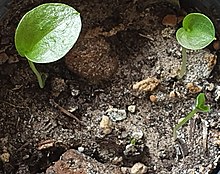en
names in breadcrumbs


Arisarum is a genus of flowering plants in the family Araceae. It is native to the Mediterranean region, east to the Caucasus and west to Macaronesia.[2][3][4]
Accepted species:[2]
It is closely related to the genera Ambrosina, Peltandra, and Typhonodorum. Ambrosina is the sister group to Arisarum, from which it separated about 46.1 Million years ago.[1]
The precise relationships are displayed in the following cladogram:[1]
Ambrosineae Arisareae PeltandreaeIn A. simorrhinum, the flower stalk is shorter or equal in length to the leaf stalk, whereas in A. vulgare, the flower stalk is longer than the leaf stalk. A. vulgare also has a generally longer spadix than A. simorrhinum.[5]
Arisarum foliage is parasitized by the siphonous green algae Phyllosiphon arisari Kühn. It induces necrosis in leaf tissue, after invading the intracellular space.[6] The foliage also may be affected by two species of fungi, namely Phyllosticta arisari and Melanustilospora arisari. The scale insect Icerya purchasi also feeds on Arisarum.[7]
Arisarum is a genus of flowering plants in the family Araceae. It is native to the Mediterranean region, east to the Caucasus and west to Macaronesia.
 Seeds of Arisarum simorrhinum Durieu
Seeds of Arisarum simorrhinum Durieu  Seedlings of Arisarum simorrhinum Durieu
Seedlings of Arisarum simorrhinum Durieu